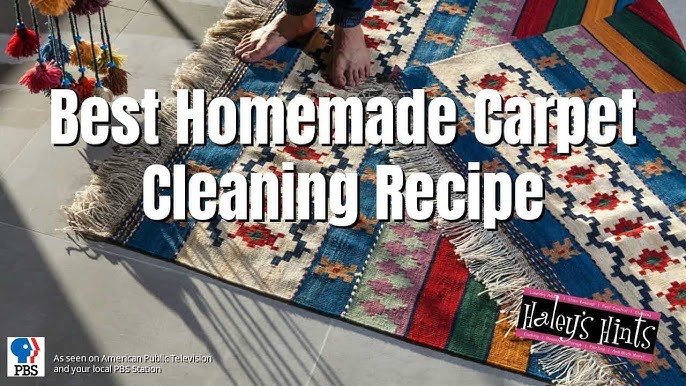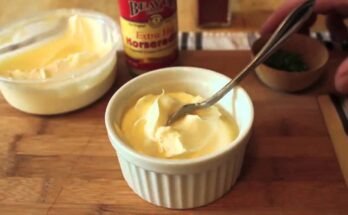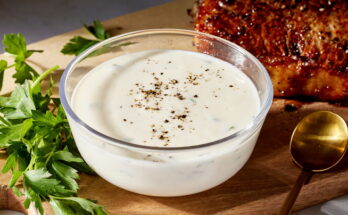Homemade Carpet Cleaner Recipe: Keeping your carpet fresh and spotless doesn’t always require a trip to the store or hiring a professional cleaner. With a few simple ingredients from your kitchen, you can whip up powerful and safe homemade carpet cleaners that get the job done beautifully.
Why Go Homemade?
Let’s be honest—store-bought carpet cleaners often come loaded with chemicals you can’t even pronounce. When you create your own cleaner, you control exactly what goes in. No hidden toxins, no strong artificial fragrances—just pure, safe cleaning power. Plus, it’s incredibly cost-effective. Why spend a fortune on commercial brands when your pantry holds everything you need?
Homemade carpet cleaning solutions are also customizable. Got a stubborn stain? Add a bit more baking soda. Need to freshen the whole house? A few drops of lavender essential oil do the trick. It’s like crafting a tailor-made cleaning solution that’s just right for your home.
Beyond saving money and promoting safety, there’s the environmental benefit. Fewer chemical cleaners mean fewer toxins in our water supply and less plastic waste. Going homemade isn’t just a personal win—it’s a planet win.
The Benefits of DIY Carpet Cleaners
Making your own carpet cleaner isn’t just about saving a few bucks. Here are some standout benefits:
- Eco-Friendly: Most DIY recipes use biodegradable ingredients.
- Pet and Kid-Safe: No harmful chemicals lurking on your floors.
- Customizable Scents: Choose the fragrances you actually enjoy.
- Tackle Specific Problems: Tailor the mixture to different stains (wine, coffee, pet accidents).
- Always Available: No need to run out to the store when an accident happens—you have everything you need at home!
So whether you’re dealing with everyday dust or a major spill, homemade carpet cleaners are your secret weapon to maintaining a clean, cozy home.
Essential Ingredients for Homemade Carpet Cleaner
Before we dive into whipping up our magic mixtures, let’s talk about the everyday ingredients that make it all happen.
Common Household Items You’ll Need
You’ll be surprised at how many powerful cleaning agents you already own. Here’s a quick rundown:
- Baking Soda: A natural deodorizer and gentle abrasive.
- White Vinegar: Breaks down stains and eliminates odors.
- Hydrogen Peroxide (3%): Great for deep stains like blood or wine.
- Dish Soap: Cuts through grease and grime.
- Essential Oils: (Lavender, tea tree, lemon) for that fresh, clean smell.
- Water: The universal solvent!
- Spray Bottles: For easy application.
You might also have things like cornstarch, rubbing alcohol, and salt, all of which have their place in specialized carpet-cleaning recipes.
Stocking up on these basics ensures you’re ready for any carpet-related emergency that comes your way.
Natural vs. Chemical Cleaners
There’s a time and place for everything—but when it comes to cleaning your carpets, natural often trumps chemical. Here’s why:
| Aspect | Natural Cleaners | Chemical Cleaners |
|---|---|---|
| Safety | Non-toxic for pets and kids | May contain harmful substances |
| Environmental Impact | Eco-friendly | High waste and pollution |
| Cost | Low-cost ingredients | Can be expensive |
| Versatility | Multi-use (other household uses too) | Specialized use only |
Natural cleaners provide peace of mind. You’re not just cleaning; you’re creating a healthier living environment. And let’s be real—who doesn’t love the idea of turning kitchen staples into a super-cleaning force?
Step-by-Step Homemade Carpet Cleaner Recipes
Now for the fun part! Let’s mix up some magic.
Simple Baking Soda and Vinegar Cleaner
Ingredients:
- 1 cup baking soda
- 2 cups white vinegar
- 2 cups warm water
- 10 drops of your favorite essential oil (optional)
Instructions:
- Sprinkle baking soda generously over the carpet.
- Let it sit for 10-15 minutes.
- In a spray bottle, combine vinegar, warm water, and essential oil.
- Lightly spray over the baking soda.
- Wait until it fizzes and then scrub lightly with a brush.
- Let it dry completely and then vacuum thoroughly.
This method is excellent for general freshening and mild stains. The combination of baking soda and vinegar works wonders in lifting dirt and neutralizing bad odors.
Deep Cleaning with Hydrogen Peroxide and Dish Soap
For those stubborn, set-in stains that mock your every cleaning attempt, this recipe packs a punch.
Ingredients:
- ½ cup hydrogen peroxide (3%)
- 1 teaspoon dish soap
- 1 cup warm water
Instructions:
- Mix all ingredients in a spray bottle.
- Test on a small hidden area of your carpet first.
- Spray directly onto the stain.
- Let it sit for 5–10 minutes.
- Blot (don’t rub!) the stain with a clean cloth.
- Rinse with a bit of warm water and blot dry.
The hydrogen peroxide acts as a natural bleach (without the harshness), while the dish soap cuts through tough grime. Together, they tackle everything from wine spills to muddy paw prints.
Freshening Up with Essential Oils
Sometimes your carpet just needs a refresh rather than a deep clean. That’s where essential oils come in.
Ingredients:
- 1 cup baking soda
- 20 drops essential oil (choose your favorite)
Instructions:
- Mix the baking soda and essential oil in a bowl.
- Sprinkle evenly across the carpet.
- Let it sit for 30 minutes.
- Vacuum thoroughly.
Use calming lavender for bedrooms or bright citrus oils for living areas. This method not only freshens up your carpet but your entire home.
Tools You’ll Need for Cleaning
You don’t need fancy gadgets to clean your carpet, but a few key tools make the job easier.
Basic Cleaning Tools at Home
Here’s your essential toolkit:
- Spray Bottles: For applying liquid mixtures evenly.
- Soft Bristle Brush: To work the cleaner into the fibers.
- White Cloths/Towels: Colored ones may transfer dye.
- Vacuum Cleaner: A must for before and after cleaning.
- Measuring Cups and Spoons: Accuracy matters!
Most of these items are probably already lying around your house, which makes starting your carpet-cleaning adventure even easier.
Optional Equipment for Better Results
If you want to take it up a notch:
- Carpet Shampooer: Great for deep cleans.
- Steam Cleaner: For sanitizing as you clean.
- Handheld Scrubber: Saves time on bigger areas.
Using the right tools ensures your DIY efforts pay off with a carpet that looks (and smells) professionally cleaned!
Pro Tips for Carpet Cleaning Succes
Cleaning your carpet with homemade solutions can be incredibly rewarding—but only if you do it right. Let’s talk about how to make your carpet sparkle without any rookie mistakes.
Mistakes to Avoid
Even the best homemade carpet cleaner won’t work magic if you’re making these common mistakes:
- Over-Wetting the Carpet: Soaking your carpet can cause mold and mildew. Always spray lightly and blot rather than douse.
- Skipping the Test Patch: Always test your cleaning solution on an inconspicuous area first. You don’t want discoloration in the middle of your living room.
- Scrubbing Too Hard: Vigorously scrubbing can damage carpet fibers and spread the stain. Blot gently instead.
- Using Colored Towels: Always use white cloths to avoid transferring dye onto your carpet.
- Ignoring Drying Time: Let the carpet dry completely before walking on it to avoid re-soiling or compressing the fibers.
These small details make a huge difference between a carpet that looks “meh” and one that looks freshly installed.
Best Practices for a Long-Lasting Clean
Want that fresh carpet feeling to stick around? Follow these golden rules:
- Vacuum Regularly: Even if the carpet doesn’t look dirty, vacuum at least twice a week to prevent dust and debris buildup.
- Treat Stains Immediately: The quicker you act, the easier it is to remove a stain completely.
- Use Doormats: Place them at all entrances to catch dirt before it hits your carpet.
- Rotate Furniture: Moving your furniture occasionally prevents crushing carpet fibers in one spot and extends its lifespan.
- Deep Clean Seasonally: Even with spot cleaning, deep clean your carpets every 3–4 months for best results.
Cleaning carpets isn’t just about appearances; it’s about creating a healthier home environment. Regular maintenance prevents allergens, dust mites, and even bacteria from making themselves at home in your carpets.
FAQs about Homemade Carpet Cleaner Recipe
Can I use homemade carpet cleaner on all types of carpets?
Most homemade carpet cleaners are safe for natural and synthetic fibers. However, always test a small, hidden area first to ensure the solution won’t cause discoloration or damage.
What ingredients are best for making a homemade carpet cleaner?
Common ingredients include white vinegar, baking soda, dish soap, hydrogen peroxide, and essential oils. These natural components help lift stains, remove odors, and refresh carpet fibers.
Is vinegar safe for carpet cleaning?
Yes, diluted white vinegar is excellent for breaking down stains and neutralizing odors. Just be sure to mix it properly with water to avoid any lingering strong smell.
How do I remove tough stains like wine or pet accidents?
For tough stains, sprinkle baking soda over the spot first, then spray with a mixture of vinegar and water. Let it fizz and sit for a few minutes before scrubbing and blotting clean.
Can I use a homemade carpet cleaner in a machine?
Absolutely! Many homemade recipes can be used in carpet cleaning machines. Just avoid recipes with too much soap or foam, as they can clog the machine.
How often should I clean my carpet with a homemade solution?
Spot clean as needed, and consider a deep clean every 3–6 months depending on foot traffic, pets, and overall household needs.
Will a homemade carpet cleaner remove odors?
Yes! Ingredients like baking soda and vinegar are natural deodorizers that effectively neutralize carpet odors instead of just masking them.
Are homemade carpet cleaners safe for pets and kids?
Most recipes are non-toxic and much safer than commercial chemical cleaners, but always double-check the ingredients to ensure they are pet- and kid-friendly.
Do I need to rinse the carpet after using a homemade cleaner?
In most cases, a thorough blotting and air drying are enough. However, if you notice any residue, a quick wipe with clean water will help.
What’s the best way to dry the carpet after cleaning?
Open windows, use fans, or turn on the air conditioner to speed up the drying process and prevent mold or mildew buildup.
Conclusion
There you have it—a complete guide to creating your own homemade carpet cleaner and using it like a pro. Whether you’re targeting stubborn stains, refreshing the entire room, or just doing some maintenance, DIY solutions are effective, safe, and super affordable. Plus, making your own cleaner lets you avoid all the harsh chemicals and fake perfumes found in store-bought options. It’s a win-win for your home, your health, and even your wallet.
Armed with these recipes, tips, and tools, you’re ready to tackle any carpet situation that comes your way. So roll up your sleeves, mix up your magic potion, and let’s make those carpets look brand-new again!



